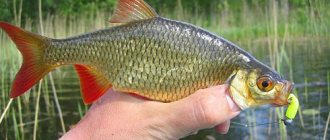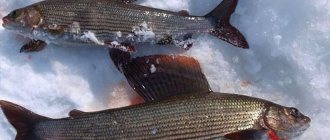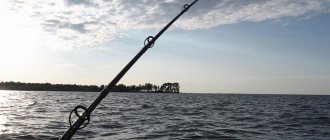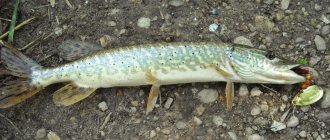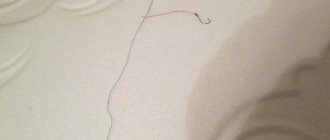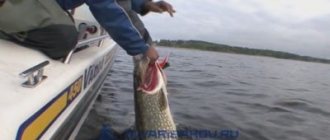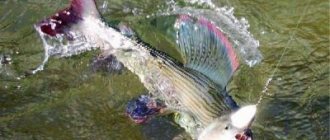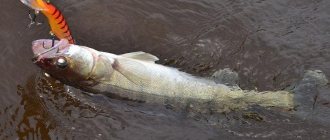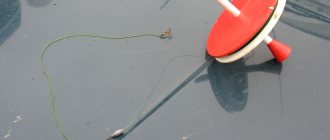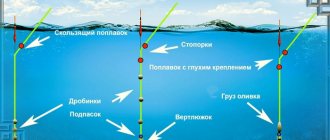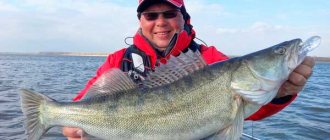Nowadays, a large number of unafraid fish in a reservoir is a rarity, and catching a trophy specimen is a huge success. Therefore, trolling seems to be a more preferable option than traditional casting from the shore. In this way, you can get very respectable specimens even under seemingly unfavorable conditions.
Today we will get acquainted with fishing techniques, without neglecting the basic principles of selecting gear and related equipment. Contrary to popular belief, trolling is not as expensive as it is made out to be, but you will have to fork out quite a bit of money when preparing for your first trip. But don’t be upset: with proper organization, the costs are offset by the joy of a good catch.
General understanding of trolling
Trolling is a method of catching a predator from aboard a self-propelled craft. Its closest relative is the track, which involves fishing from a rowing boat. A troller does not need to pump up his muscles with oars: the motor is responsible for moving the craft.
This bait provides a rich catch even with a bad bite! More details Posting (more precisely, towing) of the bait is carried out by moving the watercraft (usually at low speeds). Typically, several similar gears are used based on powerful spinning rods loaded with artificial bait or (less often) animal bait. Baits are served at a sufficient distance from each other and at different depths in order to ensure a high fishing density and avoid tangling of gear.
Trolling is the most common method of recreational sea fishing. In such open spaces there is room to roam, so fishing is carried out from fairly fast boats. Sea trolling requires very powerful gear, as very heavy and stubborn baits are used, carried out at considerable depths, and the size of the prey can be truly fantastic.
Until recently, freshwater trolling was on the verge of being banned: the fisheries authorities did not welcome such fun. However, now it is allowed in almost all reservoirs, which is what fishermen use.
Freshwater trolling has its own specifics. Fishing is carried out in relatively small water areas (lakes and reservoirs, shallow oxbow lakes, edges along river beds and pits). The depths are not so significant and rarely exceed 5-6 meters. However, the nature of the bottom is sometimes unpredictable, so the risk of the bait getting caught is much greater (especially if fishing is carried out deep to the bottom).
Mostly large pike perch and pike are used as trophies. However, large asp, humpback perch, burbot or catfish may be tempted by the bait.
What is the essence of trolling?
The main hunting strategy lies in catching trophy fish only from a floating boat on which spinning rods are attached. The modern method of fishing is based on delivering bait to a given deep layer, towing it around the territory, and monitoring bites. Equipping with electronic devices for navigation and echolocation significantly helps to search for prey in the open waters. The availability of motorized small vessels has made mobile fishing popular, replacing the track, i.e. towing baits on a rowing boat. It is recommended to study trolling and what it is in fishing together with experienced fishermen.
During the movement of a vessel through a body of water, several gears, similar in parameters, with different types of baits for hunting in the surface and deep layers are simultaneously used.
Trolling fishing pattern at different depths
Effective fishing requires knowledge and practical skills:
- implementation of the correct selection of trolling rods for small vessels.
- taking into account possible hooks of the bait during wiring.
- choosing the optimal speed.
- use of technical means.
- study of the characteristics of the reservoir, species of predatory fish living in the hunting area.
Mastering even the basics of trolling requires the angler to have good coordination and the ability to quickly respond to constantly changing conditions when moving a motorized vessel.
Trolling Equipment
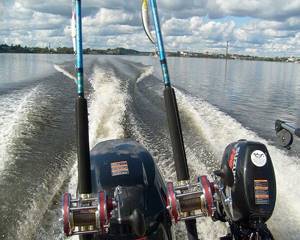
When choosing gear and auxiliary equipment, you should focus on the conditions of a particular body of water. As mentioned above, purchasing equipment will require significant financial costs.
All trolling equipment can be divided into three broad categories:
- tackle and equipment (rods, reels, lines, baits);
- watercraft (usually a boat with a low-power motor);
- auxiliary equipment (echo sounder, navigator, downrigger and other additional arsenal).
The main requirement for all components is reliability, ease of use and unpretentiousness.
Tackle
The basis of the equipment is a trolling (that is, powerful spinning) rod. There may be several of them, since in this case, unlike casting fishing, the rod is in a special rack and rigidly fixed. Trolling with one rod, for example, at the mouth of the Volga, is, to say the least, irrational: it’s simply a pity to burn fuel for this. However, the more spinning rods, the higher the likelihood of tangling the gear, so a beginner should stick to one or two powerful “sticks”.
The reel should match the rod: powerful and durable, with a well-tuned drag - what if a catfish or a ten-kilogram pike covets the bait?
All that remains is to select a fishing line with a high breaking load and the appropriate bait (usually a deep-sea wobbler) - and you can go after a trophy predator. And now more details.
Rod
Trolling is not a delicate jig; super-sensitivity of the form is not important. Retrieving is carried out due to the advancement of the craft, the animation is independent, the trophy ideally hooks itself. This determines the specifics of choosing a fishing rod.
It is worth choosing a powerful blank, positioned as a rod for trolling fishing. The length of such spinning rods is small - 1.8-2.4 m. Longer sticks are used in cases where fishing is carried out with three or more tackles (they need to be spread apart as much as possible to avoid entanglement).
It’s worth talking about other parameters in more detail.
Material
Most spinning rods are made of carbon (graphite, carbon fiber), fiberglass and composite materials (a mixture of carbon and fiberglass). For coastal fishing, sensitive and lightweight carbon blanks are definitely preferable, but sometimes they are not very suitable for trolling (they are inferior in reliability to fiberglass, and lightness and sensitivity are not needed here).
Therefore, it is rational to choose a form made of fiberglass or composite, especially since they are significantly cheaper. There are also particularly reliable trolling blanks made of carbon fiber. They are almost ideal, but, unfortunately, they are in a fundamentally different price category.
Build
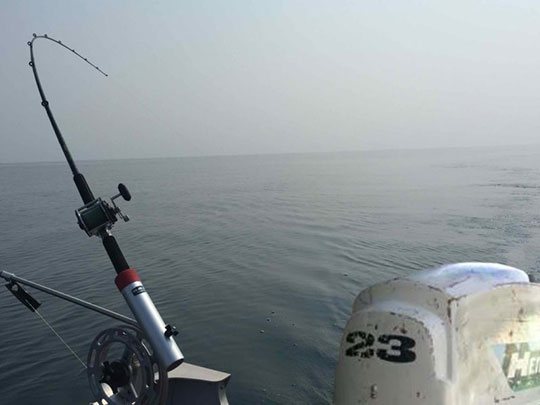
The structure of a fishing rod is determined by its flexibility. Fast action rods bend under load in the upper third (super-fast - in the upper quarter), medium - up to half, slow - almost up to the butt.
When trolling, the rod is subject to extreme loads, so it must adequately handle the hooks, taking blows along its entire length. A huge load is also expected when biting. It would seem that a slow action rod would be better.
However, on the other hand, the tackle is designed for self-hooking, which implies high rigidity of the blank. But such a rod will simply break under critical load, and at a decent speed (when fishing vast areas) it will tear the bait out of the fish’s mouth.
Therefore, as a universal option, we can recommend a medium or medium-fast spinning rod. If fishing is carried out near the bottom at significant depths, a slow stick is more suitable; on the surface of a clear water area, a medium-fast one is more suitable.
Test
The blank test should correlate with the weight of the bait. However, it must be borne in mind that even light baits equipped with blades and other accessories can provide very significant resistance when retrieving. Moreover, the greater the depth and the higher the speed of movement, the greater the resistance.
For light trolling at shallow depths, they usually take forms with 20-50 grams of dough. With increasing depths, the test increases to 50-80 grams. Heavy-duty rods with dough up to 200 grams in tandem with particularly stubborn baits are used extremely rarely in freshwater trolling, usually in the waters of very large lakes and floodplains of giant rivers (their main element is the sea).
Accessories
You should pay no less attention to the characteristics of the fittings:
- Rings . The rings should be as smooth as possible, preferably with a large diameter, otherwise they will clog quickly. Material: high-strength steel alloys or titanium (unfortunately expensive). The attachment to the form is uncompromisingly reliable, low, on three or more “legs”. It is important to have ceramic inserts that minimize friction. Cool frame rings with Sic inserts are produced by Fuji, but they are only installed on premium blanks made of high-modulus carbon.
- Handle . The configuration of the handle should provide comfortable fishing using two hands. The cork handle, ideal for shore fishing, is not suitable for trolling: it quickly chips under load. This means that it is better to focus on more reliable artificial polymers, such as EVA or neoprene.
- Reel seat . Definitely metal, without any play or external signs of poor quality workmanship. If a multiplier is used when equipping a spinning rod, it is important to have a special trigger (trigger).
Trolling rod
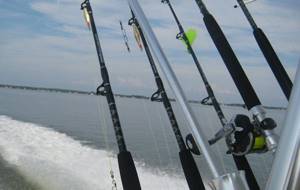
When trolling fishing, the sensitivity of the blank is not important, but its strength and reliability are important. Considering the specifics of this fishing method, you should opt for a powerful stick made from:
- fiberglass;
- composite material, which is a mixture of carbon fiber reinforced plastic (carbon fiber) with fiberglass.
Length
The length of the rod is chosen depending on how much gear will be used:
- when using one or two spinning rods, the optimal length of the blank is 1.8-2.4 m;
- if you plan to fish with three or more sticks, then they should be longer (2.7-3.3 m) to ensure spreading at the maximum distance and avoid entanglement.
Test
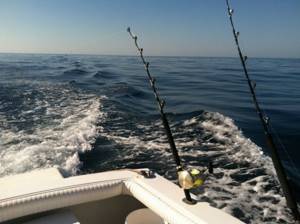
When determining the class of spinning rod according to the test, which shows the optimal weight range of the baits used, they take into account the fact that even the lightest of them can provide noticeable resistance when retrieving, and with increasing speed and depth it increases:
- If trolling is planned at shallow depths, use rods with dough from 15 to 50 g:
- average;
- medium-heavy.
2. For deeper fishing, take heavy tackle, with a dough of 50-80 g.
3. An extra-heavy blank with a test value of up to 200 g is mainly used for sea trolling, and very rarely for freshwater:
- in vast lakes;
- in the floodplains of very large rivers.
Build
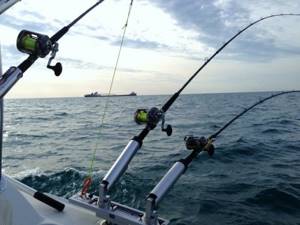
With the trolling method, self-hooking occurs, which requires sufficient rigidity of the stick. At the same time, the rod is subjected to extreme stress when biting and must withstand impacts along its entire length, which is achievable with a slow action - too rigid tackle in such a situation can simply break. In addition, when moving at high speed, the bait can be torn out of the fish’s mouth if a spinning rod with a fast action is used. The most suitable types of form for trolling:
- average;
- medium-fast, optimal when fishing the surface of a clean reservoir;
- slow, used for deep fishing.
You may be interested in: Aluminum boats
Coil
Here we come to the most expensive piece of equipment when it comes to trolling fishing. If with this type of fishing you can get by just fine with an “oak”, unpretentious and cheap fiberglass rod, then you definitely won’t be able to save money on purchasing a reel.
In fact, there are basically only two options here: a cool powerless inertia and a multiplier. The second option is more common.
Animators
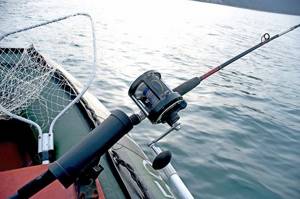
In the vast majority of cases, baitcasting reels are used for trolling. Thanks to their power and simplicity of design, they are more reliable than inertia-free ones, and in these conditions you should not pay attention to their weight. Their only drawback is the difficulty of laying the line evenly, but good models are free of this flaw.
The baitcasting reels are powerful and unhurried. They implement the winch principle: the winding movements are more powerful. Most models are equipped with line counters: this is an important point if you are fishing with several gears with given horizons, which is a common occurrence in trolling.
There are two main types of multipliers. Lighter "soap dishes" are usually used in casting shore fishing. If you take them for trolling, then only for surface trolling, without counting on hooks and record trophies like twenty-kilogram catfish.
The most acceptable are the so-called “barrels”. These are really cool power units that can cope with any load, but they also cost accordingly. The crowning glory of the creation are the multis, which are capable of changing the gear ratio depending on the fishing conditions. Transmission coils are serviced in special workshops and cost the same as second-hand cars.
Please note that the multiplier should be selected according to your hand: there are special right- and left-handed models. The spool's line capacity is from 100 m.
Inertialess
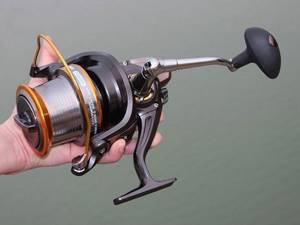
Some trolling enthusiasts still choose inertialess baits, which is quite justified for fishing at shallow depths. Firstly, they usually cost less (we don’t count premium lines). Secondly, if necessary, you can disable the clutch and carry out reeling in the usual manual mode, which is convenient when fishing for large specimens. In cartoons, the brake is always on.
And a little about the correct setting of the clutch. It must be adjusted exactly to the weight of the bait, that is, it is advisable to use a load of the appropriate weight. But, as a rule, it also has to be adjusted depending on the fishing conditions. With a weak setting, it will release the line even with micro-hooks, which is not uncommon when fishing near the bottom; with a tight setting, it will not give up the line when jerking on a dead hook, which can lead to breakage of the blank.
It is wise to take a powerful power model with a gear ratio of 1:3 or 1:4. The number of bearings is at least 4-6, and one should be allocated for the line layer. The spool must hold at least 100 m of fishing line of the required diameter with a breaking load of 7-10 kg.
What is trolling
Recently, trolling has been one of the most common fishing methods in our country. The word itself came to us from the United States and, when literally translated, means fishing from a motorized watercraft using a variety of baits that are pulled behind a boat or boat. Many people confuse this type of fishing with line fishing, but the basics of trolling are different. The main difference is the absence of a motor when fishing on the track. There is simply no such thing as trolling with oars.
Trolling is a type of fishing on a watercraft with a motor, in which bait is towed. This fishing technique is aimed at catching large species of freshwater predatory fish, such as pike and pike perch.
Trolling on the river is especially popular among our fishermen. Thanks to him, many can boast of trophy catches of impressive sizes, which they could only dream of before.
Trolling fishing is irreplaceable if:
- The fishing is planned in unfamiliar waters and there is no time to explore it;
- It's the middle of summer and the fish are hiding in the depths.
Using this technique, the option of returning home without a catch is almost completely eliminated. Besides this, there are other advantages:
- use of heavy baits;
- the ability to instantly switch to spinning fishing;
- much larger catches.
fishing line
When purchasing a fishing rod, you should immediately pay attention to the recommended characteristics of the fishing line. When using fishing line that exceeds the upper breaking load limit, the gear may break; a less strong thread or cord will cause an unreasonably large number of breaks. However, it can be used in support, where the probability of a dead hook is very high - it is better to lose the bait than to break the rod.
In the vast majority of cases, trollers are inclined to choose high-quality braids : they are at least twice as strong as monofilaments of the corresponding diameter (minus the flow resistance), and provide better contact with the bait.
However, the cord, especially under extreme load conditions, greatly frays the rings (and frays itself).
In addition, it has practically no stretchability and is not able to fully absorb the jerks of the fish, taking on part of the load. This problem can be solved by using a monofilament shock leader. This is especially true when trolling at high speeds, when fishing is carried out in vast water areas. Monofilament springs well due to stretchability and, at least, does not tear the bait out of the fish’s mouth.
So with rigid, fast action rods it is better to use monofilament or at least supplement the line with the aforementioned shock leader. In our conditions, we should not exclude the possibility that a decent-sized pike will be tempted by the bait, and it can attack proactively. Therefore, it is reasonable to supplement the equipment with a metal leash of sufficient length (up to half a meter).
Simple fishing tactics
One of the most common representatives of the underwater world that fishermen hunt for is pike perch. The fanged inhabitant of the depths occupies pits, channel edges, and the lower steps of dumps. To catch it, the boat is directed along a deep area. It is often useful to go through the hole twice from different sides. This makes it much easier to seduce a predator.
Along with pike perch, large pike are also found in the catch, so a metal leash made of string must be included in the equipment. Trolling on a small river is a separate event. As a rule, the boat is driven not along the riverbed, but along the shore edge. Most of the predator arranges ambushes there. On your first fishing trips, it is important to determine the speed of the boat. Lures should follow the working horizon without rising too high.
Lures
In this type of fishing, artificial baits are mainly used, but there are exceptions. For example, sometimes they troll peaceful fish with a bunch of worms or garlands of larvae, and offer the predator securely attached live bait. Of course, it remains a live bait only at the beginning of the retrieve: even at low speed it quickly turns into a dead fish.
But still, for the most part, trolling fishing is focused around artificial baits, used both independently and with deepeners.
Wobblers
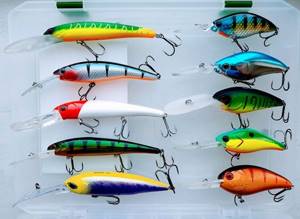
This is the main class of artificial trolling lures that even a beginner should focus on. It should be remembered that wobblers for trolling are a separate class of baits that are not suitable for casting.
A good trolling wobbler holds depth well and has its own animation that is attractive to predators and is created when the bait is pulled evenly. This is determined by the aerodynamic characteristics of the bait, which are determined by the shape of its body, the load and the configuration of the blade.
The most commonly used are special trolling minnows, pot-bellied cranks and shadows: they create powerful oscillatory movements that encourage the predator to attack.
Medium and large “divers”, that is, sinking wobblers, have the right to life. It is rational to search for a predator using wobblers with different working horizons: for example, 6 m on one tackle and 2 m on another. Moreover, you can deepen the wobbler using a downrigger, which we will talk about below.
In configuration and color, the wobbler should resemble representatives of the food supply familiar to the predator.
Spoons
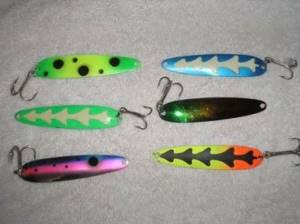
To this day, there are still trollers who prefer good old hardware. The most commonly used are heavy, narrow-bodied spoons, which pike perch are particularly partial to. They reach a given depth due to their own mass and aerodynamics, not always requiring deepening agents.
There is a huge layer of classic trolling lures with a characteristic body shape. But there are also exotic ones: these are the legendary castmasters, medium jigs, Devons, which work especially well on asp.
Turntables, although they are intended only for uniform movements, are used much less frequently in trolling fishing, since they literally jump to the surface at speed. They can only be used with downriggers and other deepeners. The only exception is the spinnerbait - a complex combination of a spinner, a jig head and all sorts of attachments.
Silicone baits

Large silicone fish look like a very attractive option for trolling. Their only drawback is their short life: delicate silicone is seriously damaged by the teeth of a predator and often the bait can only be used once. Pike sometimes simply bites off the tail of the bait, leaving slightly dazed, but unharmed. Therefore, complete with a jig head, additional hanging tees or offset hooks are used, which are passed through the body of the silicone fish.
The rest is pure benefits. Let's start with the fact that a long, wicked silicone fish gives a very attractive game that pike perch or pike cannot resist. It can be used with a jig head of any weight, selecting the optimal depth. In addition, silicone baits provide fewer hooks than their aforementioned counterparts.
Top 10 wobblers for trolling
Below we present to your attention the best wobblers for trolling.
Salmo Perch
Salmo Perch - this wobbler has a fairly large mass and is designed for catching large fish. This type of bait gives good vibration thanks to the built-in polycarbonate blade. This bait does not have balls.

The Salmo Perch wobbler imitates a small perch and is available in three depth options. Produced in Poland.
Characteristics:
- length – from 8 cm to 14 cm;
- weight – from 12 g to 62 g;
- depth – from 1.5 m to 11 m.
The Salmo Perch wobbler is used for all types of retrieves and attracts predators very well.
Jaxon Karas
Jaxon Karas resembles in its shape similar to crucian carp or silver bream. This type of wobbler deepens gradually, which allows it to be used in reservoirs with dense underwater vegetation and shallow depths.
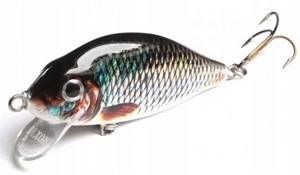
The Jaxon Karas wobbler has its own mid-frequency play and a small vibration amplitude. The bait is successfully used for uniform retrieving, as well as for “stop and go”. Quite suitable for light twitching. The color of the wobbler resembles crucian carp, sometimes there are colorful bright inserts. The noise chamber attracts predators. This type of bait is used when fishing for perch or pike.
Characteristics:
- length – from 5 cm to 11 cm;
- weight – from 6 g to 39 g;
- depth – from 0.2 m to 2.6 m.
There are options with greater weight, size and immersion depth.
Halco Sorcerer
Halco Sorcerer is distinguished by a special game - during wiring, the body oscillates from side to side. Thanks to the durable blade, the bait makes a slight noise. Halko trolling wobblers are suitable for fishing with rocky bottoms; their tail helps to avoid snags. For high speed trolling, remove the center hook.
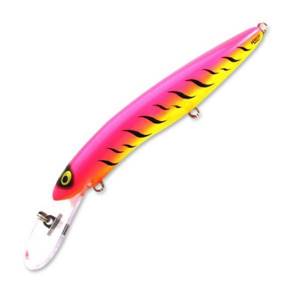
The nose blade has two replaceable options. Thanks to this, when you buy one wobbler, you practically buy two.
Characteristics:
- length – from 3.5 cm to 15 cm;
- weight – from 3.5 g to 30 g;
- depth - from 1 m to 8 m and deeper.
{banner_vnutri-kontenta-3}
Yo-Zuri Crystal Minnow DD
Yo-Zuri Crystal Minnow DD is produced by a Japanese company. This series is designed for catching pike-perch, perch, catfish or pike. This bait option is one of the most successful for deep-sea fishing. The narrow body and large blade allow the wobbler to reach great depths very quickly.
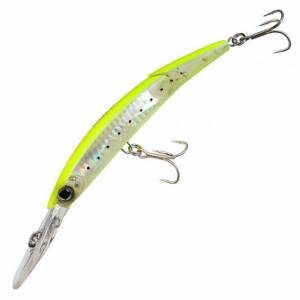
Thanks to its successful shape, the bait floats up well and makes strong vibrations, which forces the predator to rush to attack. The holographic surface and naturalistic eyes allow the fish to mistake the wobbler for a fry and attack the bait. Two large hooks do not allow the prey to escape.
Characteristics:
- length – from 9 cm to 13 cm;
- weight – from 9.5 g to 24 g;
- depth – from 1 m to 6.7 m.
Boomber DEEP LONG A
Boomber DEEP LONG A is used for catching predatory fish in ponds, lakes and rivers. Ideally balanced shape, weight, and buoyancy characteristics allow you to get a good catch of catfish, pike perch or pike. Small balls are poured into the noise chamber, and the result is a high-frequency sound.
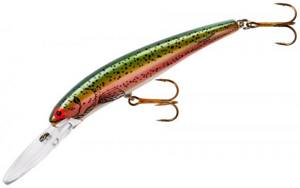
The Bomber wobbler for trolling also catches pike, but most often this wobbler attracts pike perch. The manufacturing company puts hooks of the patented THZ brand on these wobblers. They do not rust, they can be straightened and bent again without loss of quality. The body of the bait is very durable, all the reflectors are inside, under the coating.
Characteristics:
- length – 8.9 cm;
- weight – 10.6 g;
- depth – from 4.5 m to 6 m.
Pontoon 21 Panacea Marauder
Pontoon 21 Panacea Marauder is a wobbler that is used for trolling at great depths. The bait has a powerful body, resistant to damage, and a large shovel. The shape of the wobbler resembles different types of fish from the food supply of predators. This type of bait is designed for large predators and can withstand powerful attacks and heavy loads.
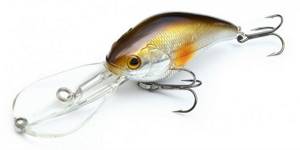
Ball balancing system improves stability and stability during wiring. Japanese fittings will not allow pike perch, pike or large catfish to escape.
Characteristics:
- length – 8 cm;
- weight – 30 g;
- depth – from 6 m.
Bat Premium
Bat Premium is a wobbler that is used as bait for deep-sea fishing for predators. Most often pike perch or pike are caught with this type of bait. The two anodized tees are very sharp and will not allow the catch to fall off.
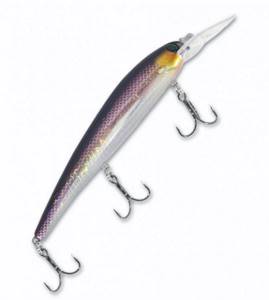
The body of the wobbler has a specific coating that imitates real fish. Holographic eyes add attractiveness and naturalism. Tunnels with metal balls make the wobbler more stable. Suitable for trolling.
Characteristics:
- length – 12.5 cm;
- weight – 22.5 g;
- depth – 3 m.
Rapala Tail Dancer
The Rapala Trail Dancer is designed for pike fishing in deep water, but is also suitable for shallow water. When trolling, this type of wobbler performs well in reservoirs and deep-water rivers.
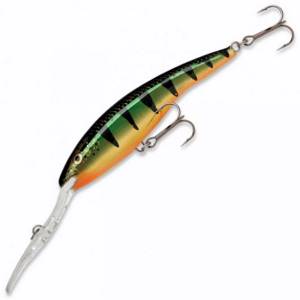
A depth of up to 9 m allows you to catch fish in wintering pits. The long blade and specific body shape help avoid snags. Reliable materials from which the bait is made contribute to a long service life.
Characteristics:
- length – from 7 cm to 11 cm;
- weight – from 9 mg to 22 g;
- depth – from 4.5 m to 9 m.
Rapala X-Rap Magnum
Rapala X-Rap Magnum is rightfully considered one of the best trolling lures. The Finnish manufacturing company has successfully combined innovative technologies with fishing tricks. The advantages of these wobblers lie not only in long casting, good sound effects or balancing.
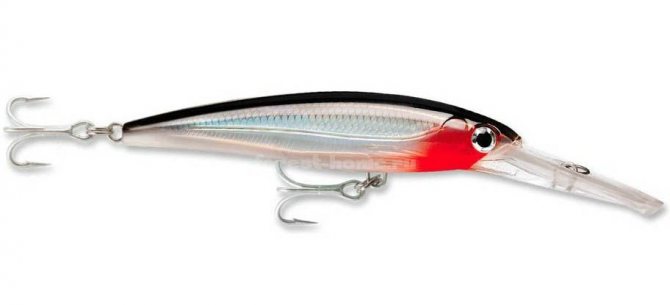
Rapala trolling wobblers can make quick turns and change direction sharply. The small shape makes it easy to control the bait. The feather tail and highlights of the holographic body add naturalness and attractiveness to the eyes of predatory fish.
Characteristics:
- length – from 6 cm to 10 cm;
- weight – from 4 g to 13 g;
- depth – from 0.9 m to 1.8 m.
Duo Realis Crank G87
Duo Realis Crank G87 is a wobbler that plunges vertically into the water. This ability is achieved thanks to the ideal shape and a large metal ball, which is enclosed in a body and fixed with a magnet.
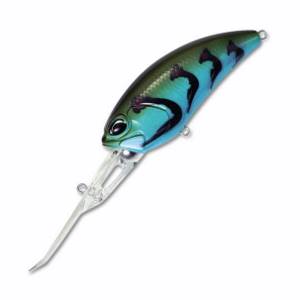
This combination leads to the fact that when pulling, the center of gravity is moved forward. The large diving depth allows you to attract predators not only near the bottom, but also in the water column.
Characteristics:
- length – 8.7 cm;
- weight – from 34 g to 35.5 g;
- depth - from 4.2 m to 6.3 m.
Most wobblers resemble live fish, are well balanced, and also have good action. When choosing bait, it is important to take into account the bottom topography, the presence of algae, and the time of year. Each trolling wobbler is good in a certain situation. When choosing gear, it is worth monitoring the quality of the fittings. She must not fail at a crucial moment. The color and size of the bait depends on the reservoir and the fish that live there.
Watercraft
For trolling in small bodies of water, any type of boat is used: both with a rigid hull (metal, wood, plastic) and inflatable (made of PVC). If an angler lives near a body of water, the choice is limited only by finances and the ability to mount an engine.
A PVC boat is more compact and mobile - it does not require a special trailer to transport it, and it is inflated using an electric pump in a matter of minutes. You can’t install a powerful engine on an inflatable punt, but cruising speeds are not required for freshwater trolling. The only obvious disadvantage is vulnerability: the side or bottom in the heat of battle with a predator can be damaged by the same hook.
Homemade targa for trolling
Fishermen often make devices for securing spinning rods themselves for trolling fishing areas. Targa is a frame made of various materials in the form of tubes on a frame. Homemade products are usually installed on small PVC boats.
Cuttings of old pipes and plastic elements of plumbing systems are suitable for production. The weight of the structure matters, so even wooden models are used. Dimensions are selected according to the size of the boat.
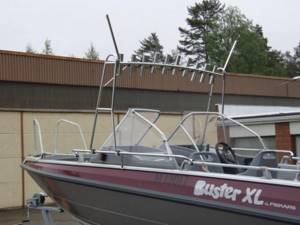
Targa to the boat
Welded targas are usually made for large boats; the glasses are attached with bolts and nuts. Here it is important to initially choose the correct angle of inclination of the holders. For simpler boats, the frames are assembled from bent aluminum pipes, PVC pipes, connected by adapters, plugs, and tightened with clamps. Installing cups under fishing rods occurs in a similar way. Fastening on boats is done using durable rubber nickels. You can purchase fastenings in the online store.
Considerable preparation by the angler before starting trolling pays off with the excitement of an exciting hunt and a guaranteed trophy.
Engine
The speed of the boat when trolling on small reservoirs and rivers is 3-6 km per hour, on a large lake or river - up to 7-10 km per hour. This is comparable to the speeds of a walking/running person.
For freshwater trolling, low-power engines (2.5-3 “horses”) are ideal, allowing you to comfortably both explore the water area and fish at low speeds (from 2.5 km/h). Another important indicator is practicality (low fuel consumption, unpretentiousness, ease of maintenance).
A good trolling engine does not roar, but purrs quietly without scaring away the fish. True, it takes a long time to get to the fishing spot, especially if the area of the reservoir is measured in tens of square kilometers.
Therefore, many experienced fishermen install two engines at once: one for delivery to the fishing spot, the second for the actual fishing. However, you need to take into account the parameters of the craft, otherwise fishing will turn into a very risky undertaking.
Motor selection
The main criteria for selecting an engine for a watercraft are power suitable for fishing tactics and quiet operation.
A characteristic growling sound is produced by domestic models of Whirlwinds and Neptunes, known since Soviet times. Boat engines of large volume and power, already at launch, accelerate all the fish with a bass roar. In contrast, modern engines from Honda and Yamaha are distinguished by excellent indicators of economical fuel consumption, power, and weight.
The downside is the high cost, which often scares away fishermen.
A low-power model with silent operation at low speeds and a power of up to 3 horsepower is the optimal choice of engine for trolling fishing. The motor will ensure smooth sailing of the vessel at a speed of 3 - 5 km/h. The lightweight engine is suitable for the necessary retrieval of the bait and maneuvering among the waves.
But low power will become a problem for the fisherman in terms of moving to the trolling site, since getting there will have to be slow and long.
A practical solution is to hang two engines, one of which serves to quickly transport the fisherman to the hunting spot and back, and the second directly for trolling. A spare motor on a boat is also needed in emergency situations in case of problems with the main engine.
A universal option for trolling on a two-seater motor boat for inland waters is considered to be an engine of 15 horsepower or more. Higher power motors are used by professionals.
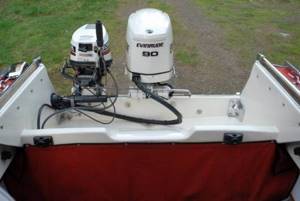
Main and additional motors
Additional equipment
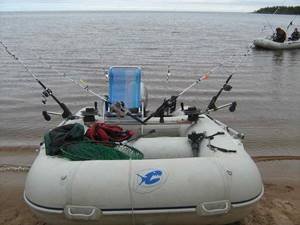
In addition to the basic one, you will need a whole range of additional equipment. Some items from this list simplify navigation on the reservoir, others are designed to improve fishing conditions.
Let's go over the main items, because each of them is an additional expense item, which, under certain conditions, may not be required.
Deepener
The predator does not sit in one place and does not wait for you to put the bait under its nose, however, reconnaissance and fishing should be carried out at different horizons, that is, depths. The depth of the bait can differ significantly from that declared by the manufacturer: it is directly dependent on the speed of the vessel, the current and other parameters.
Trolling fishing is best done on several horizons with at least two gears. To ensure wiring in a given horizon and avoid tangling of equipment, various deepeners are often used. They can be divided into three broad groups:
- Additional cargo . These are the most primitive deepeners, installed directly on the equipment. But you need to take into account that the greater the mass of the cargo, the worse the gear works, so you should not overload the equipment.
- Divers . Here we have inexpensive devices that increase the resistance of the bait and thereby deepen it. They are based on flat platforms made of artificial polymers, mounted at the end of the main fishing line (the leash with the bait is attached separately). It is difficult to achieve precise penetration to a given horizon.
- Downriggers . These are stationary and quite complex devices that are mounted on board the boat. They are winch rods with cables on which loads of a given mass are suspended. Expensive models are equipped with meters and electric drive. The downrigger is capable of guiding the bait precisely at a given horizon, and at very significant depths, but it is expensive and cumbersome.
Well, don’t forget about a landing net or hook, as well as a bag or cage for storing your catch.
Electronic devices
Trolling will never be effective if you fish without looking at the picture of what is happening underwater. Therefore, if fishing is not carried out on a small river or a well-known water area, preliminary reconnaissance of the terrain is mandatory. It will help you find the most promising places, and will also point out bottom anomalies, passing over which is fraught with snags.
An echo sounder will do an excellent job of preliminary reconnaissance of the water area, allowing you to detect promising places, measure depths and avoid unjustified risks.
But it’s better to pinpoint the route using a navigator : this will help you subsequently follow the intended course.
Other additional equipment
Among other additional equipment worth mentioning:
- Outrigger . This is an element outside the ship that allows you to attach remote equipment and gear. When using an outrigger, you can spread the gear as wide as possible to avoid tangling.
- Paravan . A special device (usually triangular in shape) that distributes bait horizontally on one tackle. At the same time it can perform the function of a deepener.
- Rod holders . There are many options for holders. The choice of the optimal one depends on many factors: the number of rods, the characteristics of the boat, the budget. In particular, for inflatable boats, “glass” holders are often used, mounted to hard seats. On more serious hull boats, special metal stands are often installed that allow you to fish with 5-7 trolling gear at the same time.
Search for a predator
As a rule, active fishing is preceded by an exploration stage. Sometimes trolling has a purely intelligence function in principle. First, with the help of a watercraft, several baits are cast at different horizons, then a promising water area is fished by casting.
As a rule, trophy pike perch and pike prefer significant depths (especially the second). Pike sometimes favor thickets, snags and other shelters, so trolling along the borders of coastal vegetation, islands, driftwood and other anomalies can be promising. But the asp prefers to hunt near the surface, because the basis of its food base is the narrow-bodied perch.
Traditionally, dumps are catchable, that is, places where the depths differ between edges, located along channels and pits. And in a deep pool you can even find catfish.
Trolling in shallow water (on the horizon up to 3 m) is good in areas of rifts and oxbow bays, but you need to understand that with the onset of heat, the fish tends to go to greater depths.
On small rivers they troll mainly along the floodplain, clinging to the dump. Fishing can be done both with the current and against it. In this case, it is necessary to focus on its speed so that the bait does not sag and does not accelerate too much.
How to properly troll for pike perch
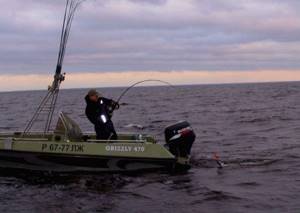
There is nothing complicated about this fishing method. When fishing in a new place, start with a little study of the reservoir. Having examined the desired area, they begin trolling.
Fishing process:
- Having equipped the boat, we sail about ten meters from the shore. This depends on the flatness of the coast, the presence of vegetation and similar nuances.
- Throw the bait into the water in a clean place.
- We move along the coast at low speed. The spinning rod can be placed in the holder and its tip observed. Experienced fishermen prefer to hold the stick in their hand. So, the blow is clearly felt. It is possible to quickly respond to a bite. You can play with the rod by constantly loosening or tightening the line. This only improves the bait's performance.
- The speed of the boat is within 2-3 kilometers per hour. Working depths are from three meters or more. A comfortable bait casting length is 20-50 meters.
Search for predator sites

This is one of the important fishing conditions. Pike perch can be based:
- In places with complex or uneven bottom topography.
- In thickets, near holes or rocky ledges.
- Pike perch loves to stand in the current. Pay attention to where rivers flow.
You need to find edges and other bottom irregularities using an echo sounder. It is necessary to fix promising places using GPS. This will allow you to pass the operating points the next time you go out on the water.
Fishing Features
Many spinning anglers catch pike perch using a jig. I agree, this is a very interesting, catchy way. However, trolling has advantages for a number of reasons:
- Mobility. You can quickly get around the likely sites of pike perch.
- Opportunity to work on a number of horizons simultaneously with a partner.
- Using conventional baits for catching pike perch and their various combinations.
Recommended reading: Chub fish
On a note! When comparing trolling with jig or twitch fishing, you can notice one pleasant feature. The size of the catch with this method is less dependent on weather conditions.
Trolling tactics in various conditions
The actual fishing tactics look like this:
- The craft begins to move and reaches a promising water area.
- The gear is loaded with baits, adjusted and cast in a fan shape.
- The rods are installed in racks, if necessary - through downriggers with a given depth.
- The craft moves, baits are towed at specified depths under the control of an echo sounder.
- When bitten, the fish usually hooks itself.
- The rod is removed from the rack and the fish is fished to the side.
Unlike coastal spinning, trolling does not require particularly honed skills. There is no need to accurately cast the tackle over a long distance, and skillfully animate the bait too. The skill of a fisherman lies in the fundamental preparation of gear and adjusting it to fishing conditions, controlling the vessel and fishing for trophies. It is also important to react to snags in time, releasing the line and slowing down the boat.
The usual length of the cord is 10-15 m, but you need to understand that on a small winding river it should be less, and on a vast clear water area and great depths it should be longer. The turns of the vessel must be smooth: otherwise the rigging may become tangled or wrapped around the propeller.
In shallow waters there is a high chance of catching grass pike or perch. There it is better to use wobblers with minimal depth, spinners or spinners. At deeper depths, where you can encounter a large predator, fairly loaded silicone baits, medium and large wobblers, as well as jigs with loading are good.
You need to understand that the use of deepeners seriously changes the characteristics of the bait, and fishing at depths of over 20 m without the use of a downrigger is very difficult.
Fishing tactics
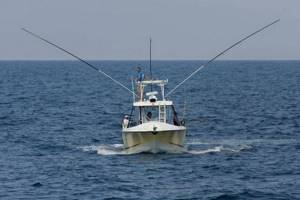
1. Fishing begins with the preparation of gear:
- they are loaded with baits;
- adjust according to fishing conditions.
2. Casting is done in a fan-shaped manner.
3. The forms are installed in holders, using deepeners if necessary.
4. Towing of baits is carried out at specified horizons, using an echo sounder.
5. Fishing begins from the deepest zones, moving slowly and using heavy baits.
6. Then they pass the dump 3-4 times, approaching from the side of clear water.
7. Next they walk along the thickets, trying to avoid snags.
8. When biting, as a rule, the prey is caught on its own.
9. Remove the stick from the holder and bring the fish to the side.
A careful approach to purchasing tackle and equipment for trolling, the correct choice of location and competent use of fishing tactics will not only ensure a successful fishing result, but will also enable the angler to fully enjoy the process itself, get a lot of unforgettable impressions and maximum pleasure.
Tips for beginners
And in the end, as always, some advice to novice fishermen:
- Pay attention to reality. Despite the fact that trolling fishing is not considered poaching, it should be taken into account that it is prohibited in some water bodies. Moreover, any fishing from a boat during the period of spawning restrictions (they are individual for each region) is poaching.
- Adjust the speed of movement. Changing the speed of the boat significantly affects the depth of the bait. And even a very hungry spring pike is unlikely to be tempted by the bait rushing past - it simply won’t have time. Therefore, if the craft is equipped with a powerful engine, it is better to slow it down with the help of special drift bags.
- Play with baits. No bait, even the most catchy one, is universal. Therefore, you will have to experiment not only with speed and depth, but also with the bait itself. For example, in summer, pike are inactive and prefer smaller prey. So it’s better to put large, thick-bodied wobblers aside, preferring small minnows, silicone or iron.
- Use additional stimulation. Trolling can be supplemented with active fishing, especially if the boat is controlled by another angler or it moves independently through free waters at low speed with a fixed rudder. The line can be reeled in, the rod can be raised up in order to attract the fish with some kind of jig step.
- Start with guidance. To begin with, it’s better to ask experienced trollers to join you, and then make a decision about purchasing your own equipment. Under their guidance, you will be able to comprehend the nuances of this amazingly productive type of fishing and understand whether you are ready to invest in an expensive hobby.
Trolling is a great hobby for the strong and brave. He may not be very athletic, but he is definitely no less an adrenaline junkie than classic spin fishing!
Fishermen wonder why I’m biting and they’re not?
I’m revealing a secret just for you: it’s all about the miracle bait! More details
Tackle for trolling zander
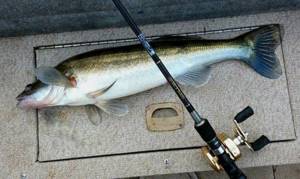
Considering the size of the trophy and the possibility of fishing in “strong” places, it is necessary to acquire durable gear. Large pike perch often stands behind snags and fallen trees, therefore, hooks cannot be avoided.
Selecting a spinning rod
The requirements for a rod for this fishing method are low and come down mainly to power reserves. It is recommended to take a stick up to 2.4 meters long. This spinning rod is quite convenient to maneuver when fishing, and there is no need for long casts. Rods with fast and super-fast action perform somewhat better, although this parameter is not very important. If hunting for a fanged fish takes place on a pond or river with a small current, a large test of the rod is not necessary. At depth and strong currents, you should take a spinning rod with an upper test limit of 100 grams or more.
A bait reel is a powerful inertial option for hard work with a trophy. If there is a counter on them, then it’s like a bonus that displays how many meters of cord have been lowered. Nylon fishing line is inconvenient to use in trolling due to its strong stretchability. A braided cord works much better here.
Wobblers for trolling
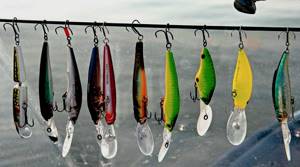
Often, beginning trollers try to take expensive wobblers. In my opinion, such a measure is not at all necessary. There are many affordable but decent options from Asian manufacturers.
When choosing a wobbler for pike perch, pay attention to:
- Maximum depth. Considering that the fanged one almost always hunts in the bottom layer, the bait must be placed near the bottom.
- Size and shape. Pike perch prefers narrow-bodied baits. Running size 80-100 mm.
- Colors. There is no clear pattern here. Sometimes realistically colored wobblers “shoot out”, sometimes bright “acid” ones.
Recommended reading: How to distinguish carp from carp
Catching pike perch by trolling involves constant experimentation.
Note! When trolling, the bait is constantly in action. The wobbler must have stable play at different speeds. In some cases, the wiring speed reaches 10 kilometers per hour.
